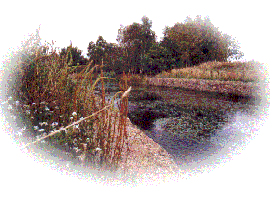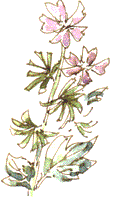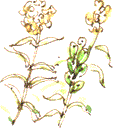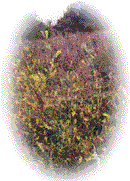Nature Diary
Rocks
History
Gallery
Links
Home Page
 THE OLD Walton Colliery Site, south east of Wakefield, was restored for use as a country park in the mid-1990s. I like to return every year or so to see the developing landscape. To begin with, in 1995, it was an area of colliery spoil bulldozed into ponds and mounds. It was still easy to pick out fossils of prehistoric plants in the grey shale alongside the tracks. Thousands of plastic tubes, each protecting a whip-like young tree, were dotted across bare slopes likes spines on a hedgehog. They have now grown to the height of a child.
THE OLD Walton Colliery Site, south east of Wakefield, was restored for use as a country park in the mid-1990s. I like to return every year or so to see the developing landscape. To begin with, in 1995, it was an area of colliery spoil bulldozed into ponds and mounds. It was still easy to pick out fossils of prehistoric plants in the grey shale alongside the tracks. Thousands of plastic tubes, each protecting a whip-like young tree, were dotted across bare slopes likes spines on a hedgehog. They have now grown to the height of a child.
 I try to imagine what it would be like to return in twenty years time, to walk through woodland and emerge in clearings where the ponds are half colonised by bulrush, reed and willow.
I try to imagine what it would be like to return in twenty years time, to walk through woodland and emerge in clearings where the ponds are half colonised by bulrush, reed and willow.
We see Coots, Mute Swans, Sparrowhawk and Green Woodpecker on a stroll around the site.
  The slopes were sown with wild flower seed mixes, which probably explains why the flora here is a little out of the ordinary. Musk Mallow has more finely divided leaves than Common Mallow, and a later flowering period. Wild Mignonette is also still in flower. Its fruits look like little green versions of the puffed wheat breakfast cereal.
The slopes were sown with wild flower seed mixes, which probably explains why the flora here is a little out of the ordinary. Musk Mallow has more finely divided leaves than Common Mallow, and a later flowering period. Wild Mignonette is also still in flower. Its fruits look like little green versions of the puffed wheat breakfast cereal.
Birdsfoot Trefoil now has its bird's foot-shaped seedpods. This plant is one of the pea family. It does well on nutrient poor ground because, like peas and beans, it has nodules on its roots in which bacteria live which fix nitrogen from the air and make it available to the plant.
 Yellow and white Mellilots, taller members of the pea family, grow nearby. I get the impression that, as the soil gets richer, mellilots are loosing out to grasses and other plants.
Yellow and white Mellilots, taller members of the pea family, grow nearby. I get the impression that, as the soil gets richer, mellilots are loosing out to grasses and other plants.
 There are a few fungi around. One bedraggled toadstool has a distinctly yellow centre to its cap, so we guess that it is Sulphur Tuft.
There are a few fungi around. One bedraggled toadstool has a distinctly yellow centre to its cap, so we guess that it is Sulphur Tuft.
 A stouter toadstool growing amongst sapling Silver Birches on a restored slope is a Boletus (or, as most of them are known botanically, a Leccinum). The boletus mycelium, the underground threads of the fungus, forms a sheath around the roots of birch. The fungus breaks down organic matter, releasing nutrients to the tree. The association with the fungus is essential to the growth of the birch as it colonises areas of poor soil.
A stouter toadstool growing amongst sapling Silver Birches on a restored slope is a Boletus (or, as most of them are known botanically, a Leccinum). The boletus mycelium, the underground threads of the fungus, forms a sheath around the roots of birch. The fungus breaks down organic matter, releasing nutrients to the tree. The association with the fungus is essential to the growth of the birch as it colonises areas of poor soil.
  A dip with a pond net in an adjoining stretch of the now derelict Barnsley Canal catches hundreds of waterfleas, Daphnia, and the odd Cyclops, a tiny crustacean trailing twin egg-sacs as it swims.
A dip with a pond net in an adjoining stretch of the now derelict Barnsley Canal catches hundreds of waterfleas, Daphnia, and the odd Cyclops, a tiny crustacean trailing twin egg-sacs as it swims.
A Garden Spider has spun its orb web using one of the stout, square kissing gates as a frame.

Richard Bell,
wildlife illustrator
E-mail; 'richard@daelnet.co.uk'
Next page
Previous page
Nature Diary
Wild West Yorkshire home page
|
 THE OLD Walton Colliery Site, south east of Wakefield, was restored for use as a country park in the mid-1990s. I like to return every year or so to see the developing landscape. To begin with, in 1995, it was an area of colliery spoil bulldozed into ponds and mounds. It was still easy to pick out fossils of prehistoric plants in the grey shale alongside the tracks. Thousands of plastic tubes, each protecting a whip-like young tree, were dotted across bare slopes likes spines on a hedgehog. They have now grown to the height of a child.
THE OLD Walton Colliery Site, south east of Wakefield, was restored for use as a country park in the mid-1990s. I like to return every year or so to see the developing landscape. To begin with, in 1995, it was an area of colliery spoil bulldozed into ponds and mounds. It was still easy to pick out fossils of prehistoric plants in the grey shale alongside the tracks. Thousands of plastic tubes, each protecting a whip-like young tree, were dotted across bare slopes likes spines on a hedgehog. They have now grown to the height of a child.
 I try to imagine what it would be like to return in twenty years time, to walk through woodland and emerge in clearings where the ponds are half colonised by bulrush, reed and willow.
I try to imagine what it would be like to return in twenty years time, to walk through woodland and emerge in clearings where the ponds are half colonised by bulrush, reed and willow.
 The slopes were sown with wild flower seed mixes, which probably explains why the flora here is a little out of the ordinary. Musk Mallow has more finely divided leaves than Common Mallow, and a later flowering period. Wild Mignonette is also still in flower. Its fruits look like little green versions of the puffed wheat breakfast cereal.
The slopes were sown with wild flower seed mixes, which probably explains why the flora here is a little out of the ordinary. Musk Mallow has more finely divided leaves than Common Mallow, and a later flowering period. Wild Mignonette is also still in flower. Its fruits look like little green versions of the puffed wheat breakfast cereal. Yellow and white Mellilots, taller members of the pea family, grow nearby. I get the impression that, as the soil gets richer, mellilots are loosing out to grasses and other plants.
Yellow and white Mellilots, taller members of the pea family, grow nearby. I get the impression that, as the soil gets richer, mellilots are loosing out to grasses and other plants. There are a few fungi around. One bedraggled toadstool has a distinctly yellow centre to its cap, so we guess that it is Sulphur Tuft.
There are a few fungi around. One bedraggled toadstool has a distinctly yellow centre to its cap, so we guess that it is Sulphur Tuft. A stouter toadstool growing amongst sapling Silver Birches on a restored slope is a Boletus (or, as most of them are known botanically, a Leccinum). The boletus mycelium, the underground threads of the fungus, forms a sheath around the roots of birch. The fungus breaks down organic matter, releasing nutrients to the tree. The association with the fungus is essential to the growth of the birch as it colonises areas of poor soil.
A stouter toadstool growing amongst sapling Silver Birches on a restored slope is a Boletus (or, as most of them are known botanically, a Leccinum). The boletus mycelium, the underground threads of the fungus, forms a sheath around the roots of birch. The fungus breaks down organic matter, releasing nutrients to the tree. The association with the fungus is essential to the growth of the birch as it colonises areas of poor soil.
 A dip with a pond net in an adjoining stretch of the now derelict Barnsley Canal catches hundreds of waterfleas, Daphnia, and the odd Cyclops, a tiny crustacean trailing twin egg-sacs as it swims.
A dip with a pond net in an adjoining stretch of the now derelict Barnsley Canal catches hundreds of waterfleas, Daphnia, and the odd Cyclops, a tiny crustacean trailing twin egg-sacs as it swims.